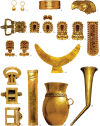Genetic insights into the social organisation of the Avar period elite in the 7th century AD Carpathian Basin
- PMID: 31969576
- PMCID: PMC6976699
- DOI: 10.1038/s41598-019-57378-8
Genetic insights into the social organisation of the Avar period elite in the 7th century AD Carpathian Basin
Erratum in
-
Author Correction: Genetic insights into the social organisation of the Avar period elite in the 7th century AD Carpathian Basin.Sci Rep. 2020 Aug 4;10(1):13398. doi: 10.1038/s41598-020-69583-x. Sci Rep. 2020. PMID: 32753726 Free PMC article.
Abstract
After 568 AD the Avars settled in the Carpathian Basin and founded the Avar Qaganate that was an important power in Central Europe until the 9th century. Part of the Avar society was probably of Asian origin; however, the localisation of their homeland is hampered by the scarcity of historical and archaeological data. Here, we study mitogenome and Y chromosomal variability of twenty-six individuals, a number of them representing a well-characterised elite group buried at the centre of the Carpathian Basin more than a century after the Avar conquest. The studied group has maternal and paternal genetic affinities to several ancient and modern East-Central Asian populations. The majority of the mitochondrial DNA variability represents Asian haplogroups (C, D, F, M, R, Y and Z). The Y-STR variability of the analysed elite males belongs only to five lineages, three N-Tat with mostly Asian parallels and two Q haplotypes. The homogeneity of the Y chromosomes reveals paternal kinship as a cohesive force in the organisation of the Avar elite strata on both social and territorial level. Our results indicate that the Avar elite arrived in the Carpathian Basin as a group of families, and remained mostly endogamous for several generations after the conquest.
Conflict of interest statement
The authors declare no competing interests.
Figures







References
-
- Golden, P. B. Some Notes on the Avars and Rouran. In The Steppe Lands and the World beyond them. Studies in honor of Victor Spinei on his 70th birthday. (eds. Curta, F. & Maleon, B.-P.) 43–66 (2013).
-
- Pohl, W. The Avars. A Steppe Empire in Central Europe, 567–822. (Cornell University Press, 2018).
-
- Sinor, D. The Cambridge History of Early Inner Asia. (Cambridge University Press, 1990).
-
- Kardaras, G. Byzantium and the Avars, 6th-9th Century AD. Political, Diplomatic and Cultural Relations. East Central and Eastern Europe in the Middle Ages, 450–1450, Volume 51. (Brill, 2018).
-
- Ligeti L. A pannóniai avarok nyelve. Magy. Nyelv. 1986;LXXXII:129–151.
Publication types
MeSH terms
Substances
LinkOut - more resources
Full Text Sources
Medical

